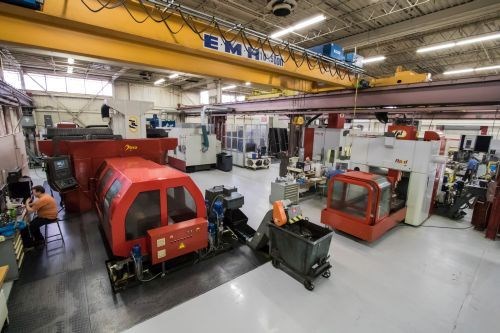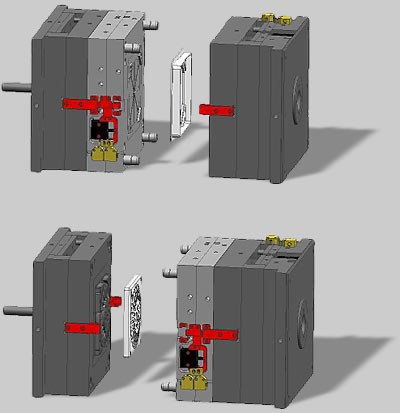Cooling Time Becomes Productive
A different take on stack tooling is helping this mold manufacturer provide substantial time and cost savings for increasing numbers of customers.

Image courtesy of Creative Technology Corp.
At first glance, they typically don't look much different than stack tools. However, molds like the one shown above offer more than the possibility to produce multiple parts in one cycle. They can often produce whole families of parts faster and on a smaller press than their more familiar cousins.
These are the benefits of a tandem mold, and the one pictured was one of approximately 10 manufactured at A1 Tool Corporation so far this year. That's more than double the amount built here since the company first started experimenting with tandem molds just a few years back. One reason is that the company's familiarity with the intricacies of this tooling has grown substantially, as has its eagerness to convince customers of the benefits.
Not Your Father's Stack Mold
Tandem molds are unlike stack tools in that all parts do not eject at the same time (in tandem). They eject in an alternating sequence: first from one parting line, then from the next. In this case, "tandem" refers to simultaneous resin injection into one parting line while material in another cools. Cooling time--which is essentially dead time in conventional molding cycles--thus becomes productive with tandem molds.

A1 Tool Corp. is a large shop, and it focuses on programs involving large molds and/or large numbers of molds for a wide variety of industries. Thin-walled container tools are a particular specialty, as are stack molds, and, recently, tandem molds. (Image courtesy of Creative Technology Corp.)
Independently operating parting lines also mean less material is required to fill all of the cavities in a tool. Opening those parting lines in an alternating sequence means the tool requires less space in the press, too. Taken together, that means a tandem mold can produce parts in the same volume as a comparable stack mold, but on a smaller press. Customers can also run the sections of a tandem mold independently, whether to keep production going while one is down or to produce complementary parts in differing volumes.
The variety of parts that can be produced with a single tandem mold is a particularly valuable advantage among A1's customers, Luther says. Many of the jobs at this 90,000-square-foot operation involve thin-walled buckets and pales in differing sizes and colors. For these jobs, tandem molding can be more cost effective for the toolmaker, too, he says, because it can eliminate the need for a stack mold with complex sequential valve gating.
Making it Happen
All of these advantages hinge on one small component: the Compact Locking System (CLS) from T/Mould, the German inventor and patentor of this technology. These devices lock each parting line before cooling so that resin can be injected into the next parting line. Meanwhile, software updates ensure virtually any standard injection molding machine can be configured properly to run parting lines in an alternating sequence. T/Mould offers the CLS devices, the software upgrade, the licenses—which require only a one-time fee—and its expertise to interested parties from its North American offices.

This image, courtesy of T/Mould, depicts the molding of a two-piece water outlet. More application examples are available on the company's website.
As a toolmaker, A1 must lend its expertise as well. The company has provided customers' first introduction to this technology in many cases, and Luther emphasizes that tandem molds aren't for every job. This makes it important to perform stringent cost-benefit analysis. For example, A1 typically recommends tandem molds only for applications with sufficient volume, he says. Similarly, cycles have to be long enough to avoid the risk of keeping parting lines closed longer than they need to be.
Yet, for the right application, the benefits can be substantial. That's why A1 is happy to spend the time and effort of parsing the details of its customer applications and this technology, among many others. After all, as detailed in this August-issue feature article, this is a company that thrives on attention to detail in all aspects of the operation.
More information on tandem mold technology, including specific application examples and “quick calculator” to determine if these tools are right for the job, are available on T/Mould’s website.
Read Next
How to Use Strategic Planning Tools, Data to Manage the Human Side of Business
Q&A with Marion Wells, MMT EAB member and founder of Human Asset Management.
Read MoreHow to Use Continuing Education to Remain Competitive in Moldmaking
Continued training helps moldmakers make tooling decisions and properly use the latest cutting tool to efficiently machine high-quality molds.
Read MoreAre You a Moldmaker Considering 3D Printing? Consider the 3D Printing Workshop at NPE2024
Presentations will cover 3D printing for mold tooling, material innovation, product development, bridge production and full-scale, high-volume additive manufacturing.
Read More







.jpg;maxWidth=300;quality=90)











